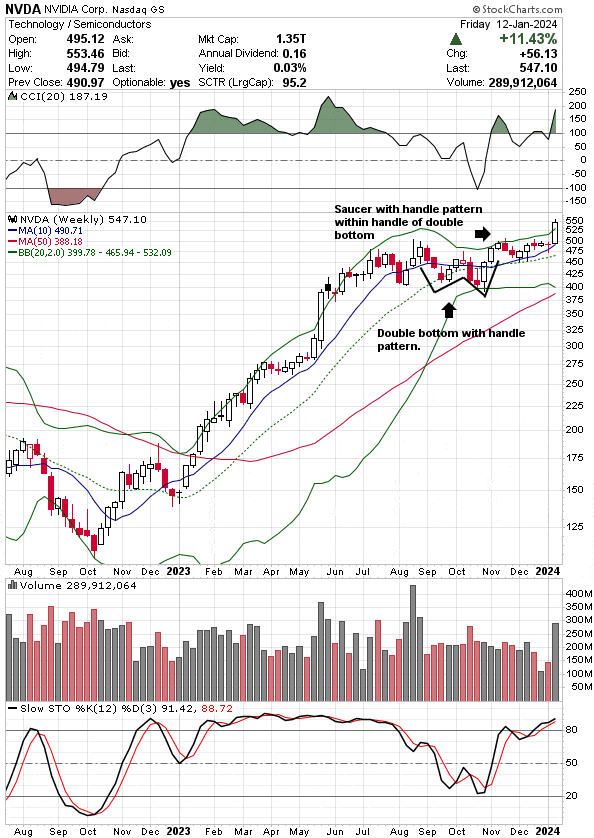Saucer with Handle Pattern and a Big Breakout
Sometimes the market hands you a gift. This year, Santa got mugged by the market during the hoped for Santa Claus rally (period between Christmas day and the first few days of the new year in this context), but week 2 of 2024 delivered two of the best trading gifts so far this year.
This blog post is a great opportunity to learn one of the most bullish chart patterns not yet covered much on the site. Its called the saucer with handle pattern.
Saucer with Handle Pattern
The saucer with handle pattern is similar to the cup with handle pattern and rounding bottom pattern.
The difference between the saucer with handle and the cup with handle is that the height of the pattern is shorter than a cup with handle. So it looks like a saucer viewed from the side versus a cup or pot.
The ratio of the height to the width is what makes the pattern look more like a saucer than a cup. The patterns that are wider relative to the height of the pattern are often thought of as saucer with handle patterns.
The handle is the sideways consolidation after the saucer shape is formed. The handle needs to run at least a week. The saucer is often generated over a longer period of time and is usually has a depth of less than 30% from the highs in the pattern (the high is the left edge of the saucer).
NVDA was an example of this pattern last week. One of the great aspects of this technical pattern is that there are actually multiple patterns. We can see a double bottom with handle and then the saucer with handle within the handle of the larger pattern (the double bottom).

Charts courtesy of StockCharts.com
The Most Bullish Saucer with Handle Patterns
As we have discussed in previous blog posts, the most bullish chart pattern is multiple very bullish chart patterns.
Like most great chart patterns, we would like these to be clearly seen on a weekly chart more so than a daily chart. “The longer the base, the higher in space” is a common axiom in trading and investing.
Actually, the most powerful patterns are shorter within a multi-year uptrend with an extreme initial move into the consolidation but in this case the fundamental factors were superior and so space may be the next stop for this stock.
This is a real classic chart pattern for NVDA and you want to study long-term trends and consolidation patterns like this on top stocks. Stocks with the explosive growth, big earnings beats and rising estimates.
Like most bullish chart patterns, we want to see the saucer with handle develop over at least five weeks. In this case it was about 7 weeks before the price reached the entry point.
Saucer with Handle Entries and Exits
The entry point is a move above the high in the handle. We did a historical study of the cup with handle patterns featured in our alert service and found this to be the most profitable entry point.
Entering the trade on the break of the trend line created by connecting the high on the left side of the pattern to the high in the handle actually produced worse results.
Why? Because many stocks will not close above the high in the handle.
This is a very important concept to understand in trading. The entry point in a bullish consolidation or bottoming pattern is usually a break of a key resistance. For instance, the double bottom entry is typically a move above the center point in the pattern or above the handle if it has one.
The entry point in a bottoming base is a move above the consolidation. This is because these levels tend to hold a tighter stop loss better if the fundamental factors for the stock are rapidly improving. A similar principle applies to 1-2-3 trend changes where the entry point is a move above the prior swing high.
We like to take some profits after the stock has moved 5% to 15%. Then raise our stop to ensure a profit which we have already done.
Fundamentals and Timing Matter When Trading Chart Patterns
What is very attractive about this swing trading opportunity is that NVDA has triple digit growth currently. The stock went up a LOT last year but earnings grew even faster.
So the forward P/E ratio is now actually less than when the move began. The AI trend is expected to last multiple years with a strong potential growth runway for Nvidia.
Estimates are still rising into earnings season which is also a good sign.
The price reached the entry point last Monday with new news. Another positive.
The price held a 1% stop-loss below the technical entry point after it was cleared and its off to a strong start. This behavior is a hallmark of big winners.
Fundamentals and Timing Matter When Trading Chart Patterns
Another great growth stock reached a good secondary entry point after a big breakout and was featured in the daily alert just after the new year. The stock is already up 13% while not falling 1% below the technical entry point once it was reached.
This one could also be a big winner this year.
This was another stock with “linearity” which to me means the downtrend, or some would call a flag, had a uniform shape and consistency before it closed above the downtrend resistance.
Overall, we are seeing a lot of good price action on top stocks over the past several weeks and it may be getting better as the Nasdaq is finally out of a correction after 2 years.
You can find our latest price target for NVDA and many other great swing trading opportunities and chart patterns in our alert service.
After More Than 10 Thousand Trades over 15 Years, These 3 Strategies Ranked Best
The New Year Sale is About to End




